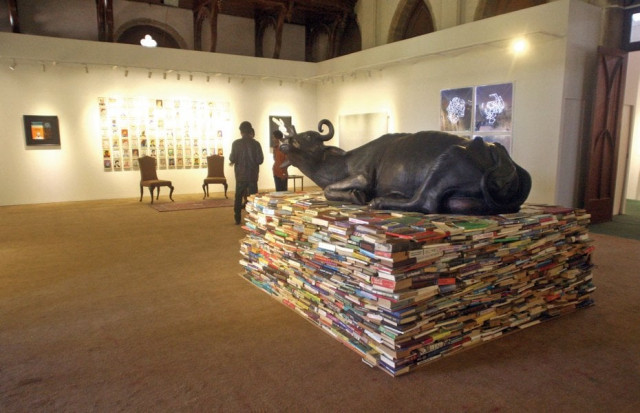Sindh’s culture is not limited to ajrak, topi, screams the art festival
Works by 63 artists, canvases from Benazir Bhutto’s private collection on display at Frere Hall.

2D and 3D works by 63 artists are being exhibited at the Art Festival at Frere Hall. The exhibition also features paintings from Benazir Bhutto’s private collection and site-specific installations set around the gardens. PHOTOS: ATHAR KHAN/ EXPRESS
Her only condition to the organisers was this: the exhibition would display works of artists of her choice — contemporary artists whose works met the international standards that Pakistan had come to be known for. “Sindh’s culture is not limited to the ajrak and topi,” she remarked, while speaking to The Express Tribune. “There is so much more to our society than just that. What I did not want was a clichéd government-type exhibition with Thari women dancing in the centre.”

2D and 3D works by 63 artists are being exhibited at the Art Festival at Frere Hall. PHOTOS: ATHAR KHAN/ EXPRESS
For the exhibition, Raja and her co-organiser, Adeela Suleman, chose the works of upcoming and established artists who had proved their worth in the field of contemporary art. The only criterion set was that the artist must have some link with Sindh. They should have either been born, raised or have spent some time in the province, explained Raja.
Inside the Sadequain Gallery, the exhibition features works by 63 participating artists, besides paintings from Benazir Bhutto’s private collection. Raja told The Express Tribune that she had hand-picked these 11 paintings out of the hundreds that were part of Benazir’s private collection. The canvases included works by the likes of Jamil Naqsh, Ismail Guljee and Sadequain, among other renowned artists.
Where these works from the masters are sure to catch the observer’s eye, the other participating artists have certainly left nothing to wish for. One of the most striking pieces was, ‘I Saw it before at the Indus Valley Civilization,’ which shows a life-size buffalo placed atop a pile of books. The sculpture was inspired by Moen jo Daro’s famed imagery of bulls and buffalos and also draws on the popular Urdu expression, ‘Aqal bari ke bhains’, picking on the country’s education system.
Paradise Garden
Perhaps the most attractive facet of the art festival is the site-specific installations that have been set up at different spots in the Frere Hall gardens. The giant cob-web, titled ‘Web gets stronger’, designed by Nabahat Lotia, is a delight to observe after sunset with a light show to enhance its ambience. Another outstanding installation is the illuminated minarets, ‘Bartle Frere’s Garden’, which is a collective effort by David Alesworth and Adeela Suleman.

The exhibition also features paintings from Benazir Bhutto’s private collection and site-specific installations set around the gardens. PHOTOS: ATHAR KHAN/ EXPRESS
The minarets are located in the centre of the courtyard space that faces the entrance of Frere Hall. The trees on all sides are lit up by 6,000 fairy lights with laser-projectors acting as their crowns. Lit up at night, the lights as well as the installations are a play on the artists’ renditions of Paradise Garden.
“This is Sindh. This whole exhibition speaks of the diversity and vibrancy that is our culture,” a visitor at the exhibition, Mariam, told The Express Tribune. Another visitor, Farad Jakhrani, agreed. “We have a very rich cultural heritage. It is time we promoted it as such.”

Rehan, who had brought his wife along, to visit the exhibition, claimed to have been swept away by the finesse of the artwork. “This is exactly what our culture has always stood for. We were painting and making sculptures and clay pots even during the Indus Valley civilisation, around 5,000 years ago. Look at the amazing works of craft archaeologists have discovered there,” he reasoned. “For the first time in Pakistan’s history, someone has taken a step to promote our culture. It is simply overwhelming.”
For the exhibition’s curator, Sameera Raja, the fact that that so many people have visited it has already made it a success. “This is why I chose Frere Hall as the venue. It is easily accessible to the larger public and also has a significant place in the hearts and minds of the citizens.” It hasn’t been an easy task though. Raja has rebuilt the walls and installed new lighting inside the gallery which will all be donated to Frere Hall once the festival is over. Moreover, the site-specific installations are here to stay too.
Published in The Express Tribune, February 6th, 2014.



















COMMENTS
Comments are moderated and generally will be posted if they are on-topic and not abusive.
For more information, please see our Comments FAQ